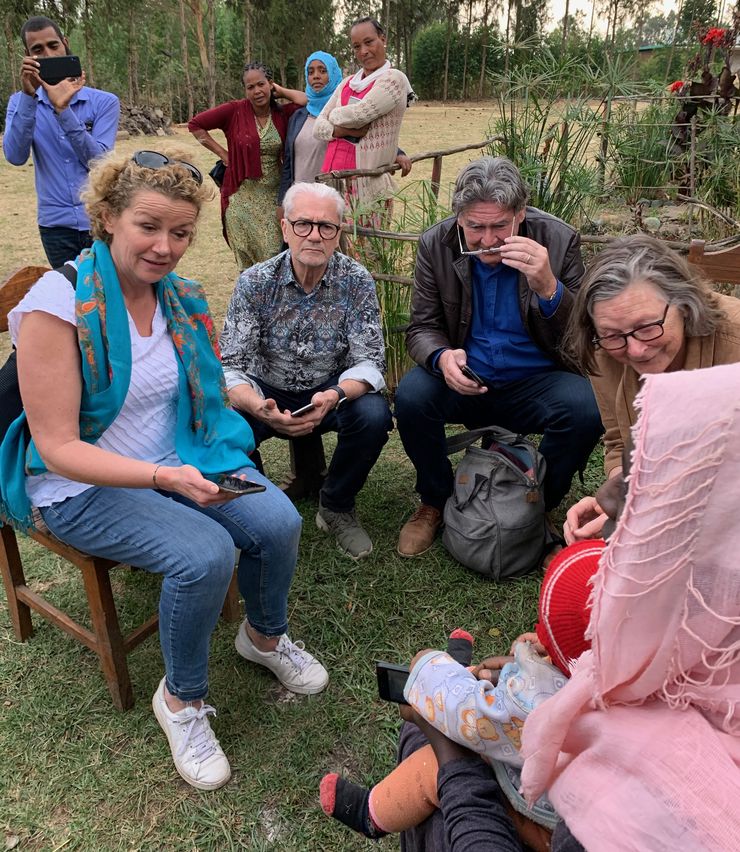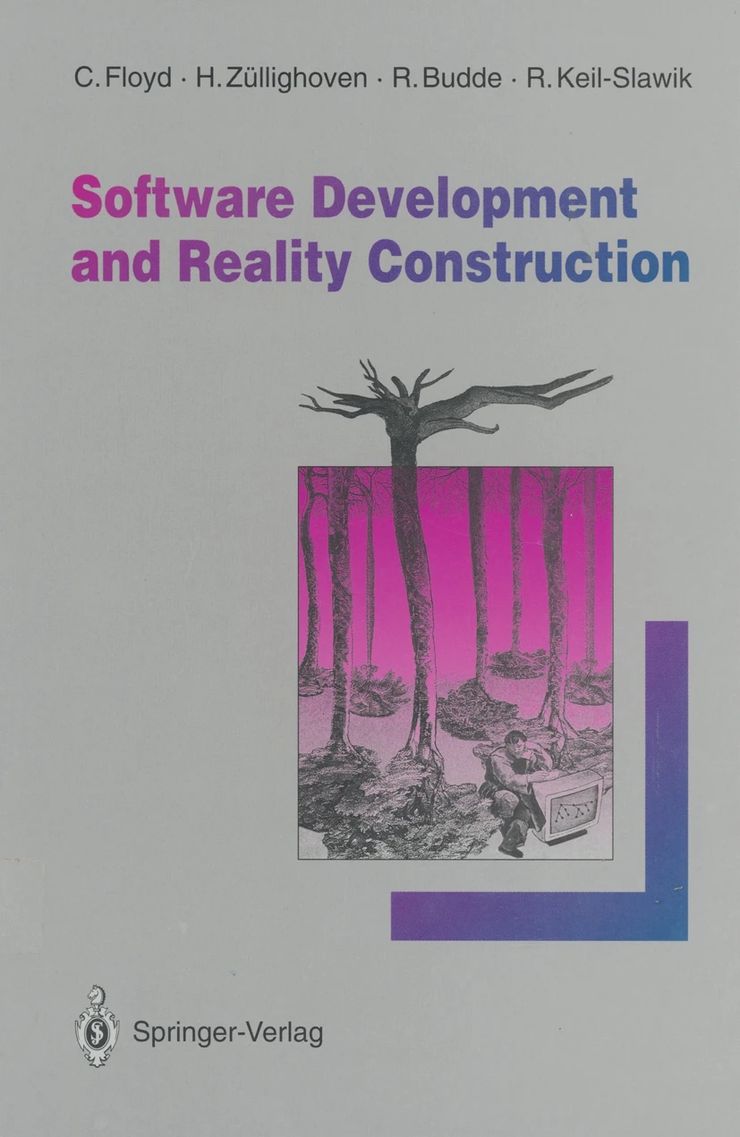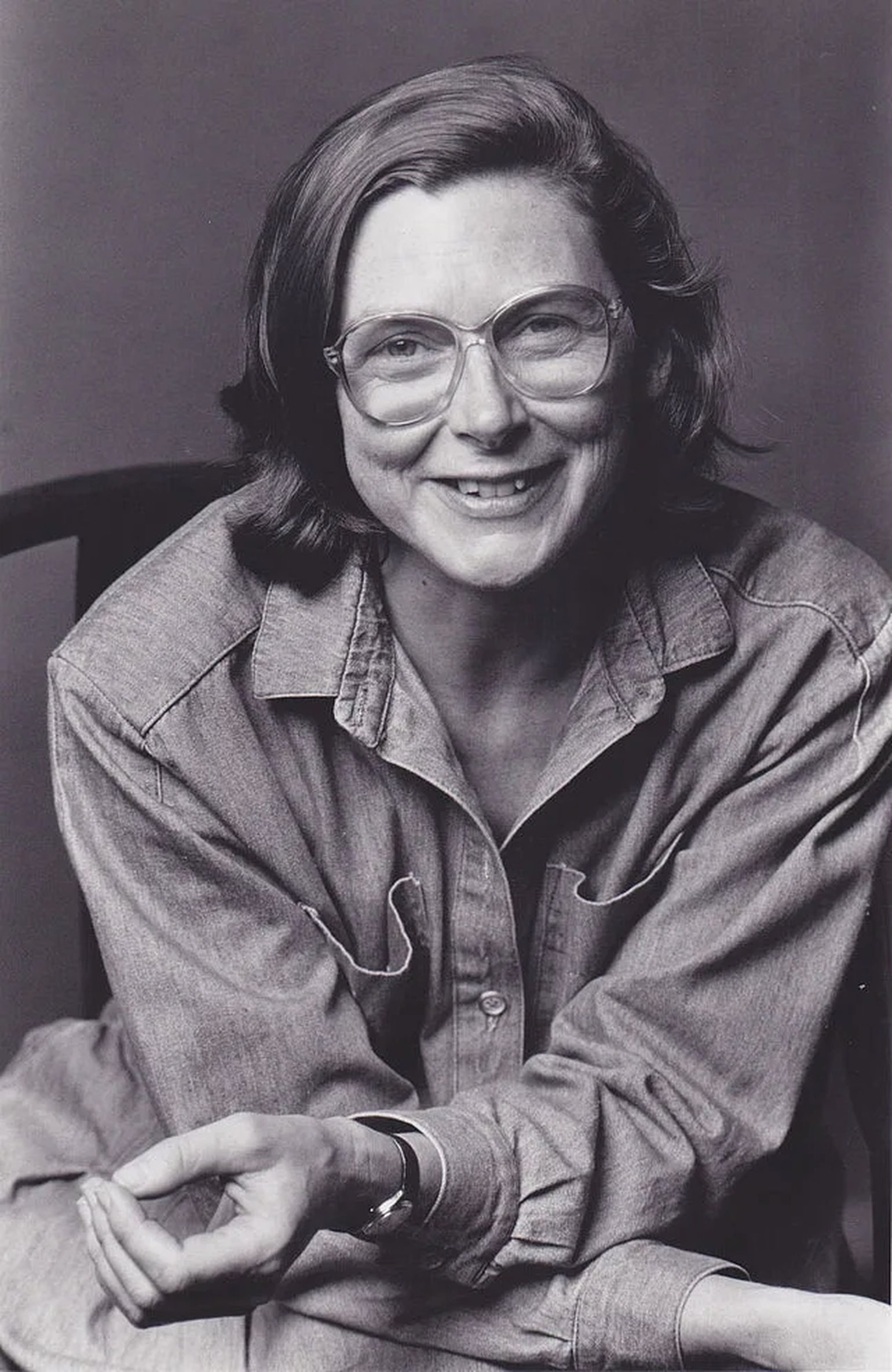The Wanderer
Christiane Floyd made her path by walking. The software engineering pioneer and passionate hiker ventured many a trail – through forests, networks, mountains, and servers.

Picture: Collage with material from stock.adobe and Tobias Schnabel by Theresa Aichinger-Fankhauser.
Christiane Floyd doesn’t like the word ‘career’. A ‘career’ is an outer shell, that speaks of a need to prove something to others. One’s own path, Floyd is sure, can only be understood in retrospect. And when you’re in the middle of it all, the only thing you truly can do is move on your own accord. Just like this line from one of her favorite poems by Antonio Machado says: “Wanderer, your footprints are the path, and nothing more.”
Alas, Christiane Floyd’s footprint is a rather large one. The Austrian computer scientist and first female professor of computer science in German-speaking countries championed emancipation through computers. With her concept of evolutionary participatory system design (STEPS), she invented a precursor idea of agile methods as early as the 1980s. But let’s start where all good hikes begin: at the home base.
Step by step: The start of a life’s adventure
If you have ever strolled through a forest in Austria, you might have gotten your boots dirty all over on one of many agricultural roads, where heavy-weighted machines turn the soil into squishy mud. How great the relief when finally encountering a narrow forest path, dry and winding, taking you deeper among the trees. “Next to my home in the Weinviertel, where I grew up, was a path that I loved. Only one person could fit there; one by one, we walked up,” Floyd remembers. Walking, step by step, became her life’s principle from an early age. “I was very independent as a child. At the age of four, I could read and started doing basic mathematics. I was thinking before being taught to think at school”, Floyd recalls.
Although many things sparked her interest, her remarkable talent led her to study mathematics at Universität Wien from 1961-66. “I don’t think I ever came to a clear decision on what to study” she says. She just explored a path. Mathematics was not her life’s ambition, she was fascinated by philosophy and much more. “I was lucky that informatics came into being around the time when I finished my studies. I belong to the second generation of computer scientists. The ‘great inventors’ were still active, and we were able to learn directly from them.” She followed them up the trail.

Picture: Christiane Floyd
Floyd started programming in 1965 when she got a summer job at the Siemens Central Laboratory during an exchange year at Universität München. She didn’t have the slightest prior education when it came to computers, but at the time, it was common to hire novices.
After earning her doctorate in 1966 she joined Siemens to tackle a great challenge: The lab she was assigned to had just started developing an ALGOL-60 Compiler for the Siemens 4004, one of the earliest fully transistor-based mainframe computers. “I had no idea what a compiler was. I didn’t even know the programming language. And, at the beginning, I was the only one on the project except for my boss. An impossible situation,” Floyd laughs. She spent many hours studying the Revised ALGOL-60 Report.
And she learned the basics of lexical and syntax analysis from an uncommented source code developed by the American Computer Scientist David Gries. The syntax checker that she built was used successfully for seven years: “I wasn’t part of the project that long, but my code was never replaced,” Floyd smirks.
The power of a new trail: Formative years at Stanford
“If you look for real change, you have to go to America,” said Jan Witt, Christiane Floyd’s boss, when she wanted to leave Siemens in 1968. A great opportunity presented itself: Floyd was offered a research associate position with Edward Feigenbaum, the famous father of expert systems, at Stanford University. She was part of the Dendral Project, a pioneering endeavor in artificial intelligence, now known as the first expert system. “The two months with the research group at the Stanford AI-Lab have shaped me for life,” Floyd says looking back. The creative, almost futuristic approach to basic research opened new worlds to the then 25-year-old. The lab hosted many marvels of AI, from hand-eye robots to the famous NLP program Eliza, computer-synthesized music, early prototypes for autonomous cars, and more.

Picture: Jason Leung
What bothered Christiane Floyd was the claim, upheld by some – but not all – AI researchers that humans were machines with the same abilities as could be implemented in computers. “I am full of admiration for AI, but I am strongly against equating humans with machines. What matters to me is how an AI system can support humans, leaving them in charge to handle human affairs. AI-systems can’t take responsibility, only humans can do that.” This remains true for the newest developments in AI, Floyd points out: “It was proclaimed that ChatGPT could pass the ‘Matura’ (1). This goes to show the remarkable power of deep learning. What bothers me is the claim that, therefore, ChatGPT is equivalent to humans who have studied eight years and have built up their own cognitive structures from experience. To make advanced AI-systems useful and safe, we need to develop appropriate scenarios for their use and leave human responsibility structures intact.”
When leaving AI, Floyd found her way back to compiler projects and eventually started teaching “Introduction to Programming” on the beautiful premises of the Stanford campus.
(1) Austrian equivalent to A-Levels, Exam to get the High School Certificate
What keeps her going: Technology for the people
Floyd strived for change from within, placing humans at the center of computing. She returned to Munich in 1973 and started working for the software company Softlab. “There was a great shift in technology back then. Interactive systems that were increasingly used in organizations and companies started to develop. But informatics was not prepared for the use of computers in the context of human work and communication,” Floyd explains. She was part of an endeavor to automate a large company’s data center. She joined late – the team worked under high pressure to finalize the project.
“When I arrived, I made a shocking realization. Not a single team member thought about how the system they developed would work in the field. What would it do? Who would use it, for what?” she remembers, “luckily, I was able to convince my boss Peter Schnupp that we were heading for disaster.” At that time, she had no clue how data centers worked but started to create a model aligning with the company’s needs, anticipating work processes and users. “Based on my model, the project was revised. The last stage was realized by two women, my colleague Rita Nagel and me, and resulted in a successful implementation.” Her experience at Softlab made Christiane Floyd aware of the struggles of putting systems into practice. She was involved in the development of new programming methods and trained colleagues. “I realized that a top-down approach can never be the answer. You need to continually communicate with the users.” In the 1970s, the users changed too. Before, programmers were experts in their systems, meaning the gap between them and so-called naive users was tremendous. But through interactive systems, they became users as well: “Suddenly, we became increasingly aware of the problems of software use, and because of that, prototyping was adopted. You just can’t know from the start if a system works in the field.”
However, taking this approach to the universities was a whole new challenge. In 1978, Floyd was appointed Professor of Software Engineering at TU Berlin. “It all began in teaching,” she remembers. In the first year, she and her assistants taught a project course. Over two semesters, groups of students had to specify, develop, and integrate a text formatter. The research unit welcomed her with a strict phase model and a formal specification language, of which they were very proud. “At first, I tried to adhere to their way, but after one semester, my students came up to me and said, ‘Christiane, we are not going to produce this formal specification’,” Floyd laughs. So, she started to turn work upside down in her project group. They discussed and made design decisions together, specified the interfaces in Pascal, and used appropriate techniques for project organization such as an incremental plan in four stages and a test group to start integration early. “In the end, we were happy to finish stage two successfully, while the other project groups had an awful week trying in vain to integrate a large system of separately developed modules” she recalls.
In the beginning, she was accused that her approach was ’not scientific’. Floyd had no theoretical foundations, but her work experience. “Creating a theoretical basis for what I was doing at TU Berlin took a lot of time and strength. My then-husband Peter Naur was a bastion of calm in this difficult time. He encouraged me to go against the mainstream,” Floyd remembers, “and don’t get me wrong; I’m very grateful that TU Berlin let me go on my own path. I’m not sure this would have been possible elsewhere.”
Christiane Floyd’s main goals were to create viable methods for real-world applications, where communication and collaboration are essential, and to develop systems with and for users. With her co-workers, in particular Fanny-Michaela Reisin and Reinhard Keil, she created the process model STEPS (‘Softwaretechnik für Evolutionäre Partizipative Systementwicklung’) – today a guiding principle of software development – which relies on prototyping, incremental version-oriented development, and continuous communication with the user organization. In the meantime, new disciplines such as Human-Computer Interaction (HCI) emerged, taking user-orientation much further. Still, how to merge HCI and software engineering remains a challenge. “Both are desperately needed, yet there is mutual distrust. We need an understanding that the practice of systems development must draw on both sides, without one looking down on the other. Different ways of thinking and methods must be integrated into informatics education,” Floyd is sure.
“When I changed my approach to SE, this led to tensions with some of my collagues.” However, she was keen to seek respectful exchange. By organizing the TAPSOFT conference in 1985, Hartmut Ehrig and Christiane Floyd found a productive way to bring together different views, inviting leading researchers in theoretical and practical approaches to software development, and discussing the relevance of formal methods at TU Berlin.
“My scientific life has been characterized by collaboration, exchange, and friendship – both within my working groups and with colleagues in Germany, Austria and internationally.
I feel privileged to have maintained a number of scientific friendships for many years. I do not see myself as a scientist working alone, but in the nexus of different intellectual currents that reached me through other researchers with whom I had deep exchanges. In particular, I have been closely connected with the Austrian born cyberneticist Heinz von Foerster who was like a mentor to me.”
This network of scientific connections enabled Floyd and her colleagues to organize a conference and later publish a book ‘Software Development and Reality Construction’, where scientists and philosophers with a range of perspectives on computing illuminated different aspects of software development’s intellectual lineage and showed how software engineering is explicitly a designing and creative activity.
In 1991, she followed a call to Universität Hamburg, where she headed the Software Technology (SWT) group together with Heinz Züllighoven and worked closely with Wolf-Gideon Bleek, Ingrid Wetzel (Schirmer) and Carola Lilienthal until retiring in 2008.
In 2012, she was appointed honorary professor at TU Wien Informatics. “The motto of TU Wien is ‘Technology for the people’, and this is what I tried to achieve my whole life. So, I feel right at home,” Floyd says.
A woman in informatics: A woman in the wild
Christiane Floyd is known to be the first female professor of computer science in German-speaking countries. But, “if I had been the second, my value or non-value would be just the same,” she explained in an interview with the German news-paper ‘Die Zeit’ (2).
What did it mean for her to be a woman in her field? Floyd was raised in the Weinviertel in Lower Austria and in Vienna. “I was very Austrian. I went to the catholic school Sacré Coeur, danced waltzes, swam, and hiked. I had many friends in Vienna. But when I moved to Munich, all this changed. The long commute to the company, extensive working hours, and hardly any time to myself, made it hard for me to enjoy other dimensions of life. And you have to remember, these were different times with very clear expectations of what it meant to be a woman,” she recalls.
When she came to California in 1968, her life changed profoundly. The wanderer in her revived, and the ‘68 movement, with its re-orientation to a simple lifestyle, the abandonment of consumer culture, and a return to nature, had a lasting impact on her. In 1970, she married the US Computer Scientist Robert Floyd and had a son with him in 1971. In the course of her divorce, she went back to Germany. “I was not on any career track. I have always lived as a woman and a mother, that came first. At the time, I knew what I left behind in California, but I wanted to raise my child in Europe,” Floyd explains.
“Back in Munich, the next steps were hard. At Softlab, we worked under capitalist conditions. There was no consideration for my child nor for me as a young single mother,” she recalls. In one project, she had to go to Saarbrücken for testing the software and to work in the computing center of a coal hut, at night and on weekends. “The men went on vacations, coming back to the office sun-tanned. And I worked through the nights and returned to my child who had just caught another flu,” she remembers vividly, “but the company also encouraged me, so I pushed through – with the help of dear friends and an au pair for my son.”
In 1975, she met her second husband, the Danish Computer Scientist Peter Naur, with whom she lived in an open marriage for ten years. They had a daughter in 1977.
The call to TU Berlin changed Floyds life tremendously. Being a professor gave her the chance of setting her own priorities and enjoying a great deal of creative freedom. Being the only woman in the field can be an advantage, according to Floyd, because she wasn’t part of the pecking order among the men. “Of course, this freedom also has its risks: you are constantly under the scrutiny of others.” Nevertheless, being a mother has taken a toll on her during her academic work as well, because “you have to reconcile two different dimensions of life, and that is becoming increasingly difficult.”
Thus, Floyd insists that sabbaticals are of special importance. They not only give the opportunity to do in-depth scientific work but also allow to dedicate more time to the family. While she was involved in making high-level scientific contacts at Stanford and Berkeley and preparing the conference Software Development and Reality Construction, she was also able to offer rich experiences to her children. “We even took our dog along as we went on adventurous trips to the mountains, the desert, and the ocean coast.”
Stronger together: ICT for Development
Retirement allows you to take your life at your own pace. Christiane Floyd does not stop to rest. She realizes projects on the egalitarian access, usage, and implementation of technology. “There is a continuously worsening information gap between those who have access to IT and those who don’t. In the 80s and 90s, I was already trying to find ways to support the use of computers in developing countries, but at that time the support was often misdirected and primarily strengthened the government of despotic leaders. " Floyd remembers.
At TU Berlin, she was an advisor for foreign students. “This opened my eyes to the completely different situation of students from developing countries: their prior knowledge, their background, their needs, and what they want to do with computer science later in life. I became aware that informatics as we teach it relies on the fact that you live and work in an industrialized country – from technology to organizational structures, from education to the division of labour. In a developing country, the structures we tend to rely on are not in place,” Floyd recalls.
In the 2000s the situation changed with the ‘miniaturization’ of technology: Smartphones, Tablets, and Laptops suddenly offered the possibility to distribute technologies directly to the people. Also, ‘ICT for Development’ emerged as a movement driven by A Min Tjoa to support the sustainable development goals of the United Nations.
Inspired by the International Women’s University for “Technology and Culture” (ifu) in 2000, where she built up the Project Area Information with Silvie Klein-Franke, Floyd gained insight into how deeply technology development was and still is influenced by the US. All over the world the US-American way of thinking must be learned and mastered by all – especially regarding the terminology, structure, and applications in software development. “This is a problem because we continue to deny existing mindsets and ways of thinking from different cultures,” Floyd is sure, “the simple word ‘knowledge’ addresses vastly different concepts worldwide. We have to acknowledge this fact and attempt to understand culturally different perspectives”.

Picture: Monika Pomberger
Christiane Floyd has been involved in Ethiopia since 2006. In her first years, she was an advisor in establishing a doctoral program at Addis Ababa University with Tesfaye Biru. Later, she helped build up the project TEMACC Ethiopia (Technology Enabled Maternal and Child healthCare) funded by the Austrian APPEAR Program, with Gustav Pomberger, Johannes Sametinger and Peter Oppelt from JKU Linz, and Rahel Bekele, Tesfaye Biru and their team from the University of Addis Ababa.
To reduce maternal and child mortality, the aim was to explore the use of ICTs for improving the access of rural mothers to the local basic health system. The methods employed were contextualized from approaches developed by her group at the University of Hamburg and Pomberger’s group at JKU. The Ethiopian team conducted field research, developed health info apps around safe childbirth for mothers, and software to support communication with and case-based treatment by local health practitioners.
The hike goes on: On the future of informatics
“What I would hope for, when I think about the future of informatics, is that we can integrate humanistic values in technical developments. Technology must have its home base in the needs of people and help humanity survive the next century. Therefore, I consider the Digital Humanism Initiative as key to future development and regulation of technology,” Floyd says.
For students in informatics, her advice could not be clearer: start exploring. Informatics is important, but it has a context. We need to explore other ways of thinking: “Information technology has a strong connection to communication – so look into communication and media sciences. If you love formal concepts or AI – make your way into philosophy. Want to really understand problems of IT use? Then get into psychology or social sciences. There are endless possibilities.”
To Christiane Floyd, the most important thing is not to be afraid of the path that opens up: “Sometimes, you need to go on a long journey and leave many things behind. But from that, you get a new sense of freedom. As Antonio Machado put it: ‘Wanderer, there is no path, the path is made by walking.’”



